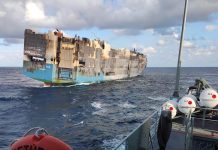
The volcanic eruption that occurred on New Zealand’s White Island last week has proven to be the deadliest event in the island’s recorded history.
There were 47 people on the island at the time, with the eruption killing at least sixteen people and seriously injuring 28.
White Island, also known as Whakaari, is an active volcano with a long history and this isn’t the first time tragedy has struck.
Before becoming a popular tourist destination, White Island was mined for its native sulphur, which has many uses, including the manufacturing of gunpowder, matches, fertilisers, pharmaceuticals, dyes, fungicides and pesticides.
Sulphur mining began on the island in 1840, with small quantities of sulphur being exported to Europe.
Over the years mining activities on the island became more established, with men living and working there from the 1880s.
Between 1885 and 1900, more than 5000 tonnes of sulphur was shipped to the mainland from White Island.
In September 1914 disaster struck in the middle of the night when part of a crater wall collapsed, causing a landslide that wiped out the small mining village.
A group of 10 miners were killed, with the only survivor being Peter the Great, a tabby cat that was rescued from the island weeks later.
The bodies of the men and the other camp cats that lived on the island were never recovered.
At first it was believed the tragedy was caused by an eruption, with fishermen reportedly seeing clouds of black smoke rising from the island.
However, it is now believed the deaths were the result of collapse of the southwestern crater rim that resulted in a huge landslide.
At the time the Otago Witness, a weekly newspaper, printed a telegraph from a sergeant that suggested the men had been buried under the debris.
“The scarcity of signs of house furniture suggests that possibly the greater portion of the living quarters was simply buried where it stood and the men with it,” it read.
Another article printed in the Wanganui Heraldsaid police had attempted to clear away the debris but had to stop due to the difficult conditions on the island.
“The police party and other willing helpers cleared away several tons of debris from the site where the men’s quarters stood but the material was too hot and steaming that the work had to be stopped,” it read.
More than two weeks after the incident debris from the landslide started washing up on beaches around the nearby Bay of Plenty, such as boat fragments and pieces of barrels.
But nothing from inside the huts were among the debris, which led people to believe the men had been buried in their living quarters in the mining village.
Two other men died on the island around the time of the disaster: John Williams, earlier in 1914, after he was badly burned in an accident with machinery, and Donald Pye who, according to a 1913 newspaper report, was thought to have fallen into the sea, the New Zealand Herald reported.
But White Island Tours, which takes tourists to the volcano by boat, tells a different tale of Pye’s demise, one cloaked with mystery since only his boots were found – near the crater.
“He either jumped into the crater or he may have been exploring and fell in,” said the company’s general manager, Patrick O’Sullivan.
Mining was resumed on the island in 1923 and continued until 1933.
Three years later the island was bought by George R Buttle and in 1953 was declared a private scenic reserve, and now around 10,000 people visit the volcano each year.
Some experts have long thought the White Island volcano was too unpredictable to allow daily tours.
Professor Raymond Cas, from Monash University in Victoria, has visited the island twice and has always feared those visiting may be put in danger.
“White Island has been a disaster waiting to happen for many years,” he told the Australian Science Media Centre.
“Having visited it twice, I have always felt that it was too dangerous to allow the daily tour groups that visit the uninhabited island volcano by boat and helicopter.”
Professor Ross Dowling, from Edith Cowan University in Western Australia, said there had been a notable increase in tourism to active volcano sites.
“Part of the attraction is to visit an unpredictable natural environment and for most tourists they assume that they will be able to visit such dangerous sites in relative safety,” Professor Dowling said.
“However, despite the increased science behind predicting volcanic eruptions, the science is not infallible and ‘active’ volcanoes may erupt at any time.
“Therefore volcanic hazard management guidelines need to be easily understood by the public so that visitors can weigh up their risks in relation to visiting such sites.”











